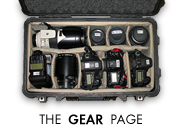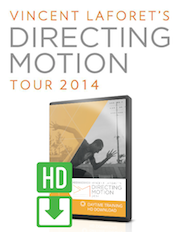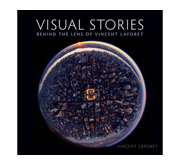To Delete or Not To Delete – “THAT” is the The Question
 One of the most common questions that have been posed by people on this blog is: Do you delete your images in camera and do you delete images on your server or in your Aperture Library?
One of the most common questions that have been posed by people on this blog is: Do you delete your images in camera and do you delete images on your server or in your Aperture Library?
I think it’s a very important question, and my answer for the most part is: No – I don’t.
Why? Well here it is: I’ll point to the following events in specific: My coverage of Hurricane Katrina, and my coverage of (actually pretty much any) Olympics. In all of these events – I was often rushing to make a deadline and under severe pressure. I had a clear idea of what the “news of the day” was and what images I needed to get out first, and I was all too often sleep deprived – in that state, I become pretty close to being my own worst editor.
And here’s a big lesson: once you make that initial edit – you almost NEVER MAKE a second edit of that work – EVER. All too often you move on to the next event or day – and never get the luxury of looking back.
And why is that dangerous? Because editing on deadline, or frankly editing your own stuff is like playing Russian Roulette for most photographers…
Simply put: Photographers are all too often their own worst editors – add to that a little stress, exhaustion or deadline pressure, and you’re playing with fire.
I can tell you that I borrowed someone else’s eyes – even complete strangers’ eyes – throughout the Olympics almost every day, to help cut down my 15 images down to the top 5. That is the hardest thing to do when you’re editing your own stuff.
Why? Because a photographer is always attempting to achieve a certain result with their photographs, they have their mind dead set on a specific goal or result – and they do not always achieve it. It takes someone else to tell them either: A. hey – I don’t really see the picture at all – I think you didn’t quite make it…it’s “not quite there mate” as one of my favorite Allsport editors Darrell Ingham used to say or B. hey – what about that picture (you haven’t even tagged) that I see over here?
In fact, my mark of a good photo editor, is not one who can pick between pictures A or B – but the one that sees photo Z – one that you never even knew was there yourself. I’ve met only a few editors who can do this throughout my career- but when you do, know that you’ve found a gold mine. These editors can literally help shape both your vision and career. They are the ones that see things in your work that you may not yet see – and they can help you shape the way you see and capture images.
I kind of skipped on this – but having a photo editor by your side is always (well almost) always, a good thing.
As with any profession – some are good and some you need to steer clear of. What you need to do is to form a relationship with an editor – let them know what you are trying to accomplish with your photography – and hopefully the two of you can go from there (and perhaps they can help you get there.) Some editors I actually go to to find out which photograph NOT to pick – I’m serious. I’ve worked with some that I can go to on a consistent basis – and when I offer them up photo A or B – if they pick B – I’ll go with A every time. While this might lead to a chuckle or two out there – it’s not necessarily because they’re bad editors – it’s because you know your style is just the polar opposite of theirs.
Something to always be aware of as both a photographer and editor: over the years, people become conditioned to edit in a certain style – often their publication’s style. You edit because you know what type of images your publication will likely run – and don’t give them ones you know will never make it in (even though you, and perhaps even your editor knows – that image is a significantly better image.)
This is one of the most dangerous aspects of working at the same publication or for the same client for too long – or for your entire career- it truly limits your growth, and the development of your vision. It can stunt your growth as a photographer. I can say that because it’s happened to me a number of times already in my career. I equate it to shooting with “your blinders on.” You stop seeing images – and are just on the lookout for the ones you know your publication will run. And that’s the death of you photographically in my opinion.
So back to deleting – sorry – I’ve gotten off target a little here. Without exception, every time I’ve gone back to do an edit – whether it’s after a 15 minute break, a 15 hour brake, a 15 day break or a 15 month break – my view of what images matter has dramatically changed. So much so – that I just can’t justify deleting images (unless they’re completely out of focus, or over exposed or under exposed beyond recovery (but hey – who knows what software they’ll write in 20 years that could potentially fix those images – you see where I’m going…???)
Think about a lot of the classic images we look at that were shot 20, 50 or 100 years ago – while some are true classics, let’s be honest: some of them really weren’t that spectacular at all when they were shot. But with time – even the most banal image – is fascinating to look at. I love to look at what people were wearing in the 1920s or what the streets looked like in New York City, how the signs in front of stores were hand painted etc. And the same will be true of what you’re photographing today – that’s a lesson my father taught me very early on – and one that I’ve never forgotten – and a big part of why I don’t delete anything if I can help it.
Sure you may think an image of an umpire walking in the background that your AF jumped to by mistake (instead of the star player in the foreground) is something you should delete immediately. But what if we don’t have umpires anymore 20 years from now (due to instant replay)… what if, that umpire happens to become one of the most famed umpire in history over time… or worse – gets into a car crash and dies that evening. You NEVER know – and keeping the frame is often the best thing to do in my book. The fact that we never really know what images will become valuable or relevant over time – is one of the magical parts of photography for me.
When I look back at the Beijing Olympics I can already see images now that I missed in my initial edit (and I might do an edit of “images that didn’t make it” at some point soon and post it on this blog) – or images that I did not chose to edit and transmit because of news value. Even more so – when I look back at my images from Katrina, I can see an entirely different edit of that event – mostly because my shooting style has changed quite a bit since then. Given that I have kept every frame – I will have the option of going back through these and every event, 10-30 years from now and / or having a great editor do the same for me.
Don’t forget: your shooting style will change with time- and the images you like now are not necessarily the ones you’ll like 20 years from now… in fact some of your current “rejects” may become your selects as your style changes…
What is the downside? Obviously, you have to buy more CF cards so that you can keep more images as you shoot, it takes longer to copy them off of the cards and import into your editing software, and you need more hard drives to store these things. But given the cost of hard drive space – it’s pretty much a non-issue for me. Look at these stats for example:
The cost of hard drive data storage seems to drop by a factor of 10 every three or four years. This means that in two years, a terabyte hard drive should cost about $20.
Here’s the cost of 1GB of Storage over the past 22 years:
1986: $100,000
1990: $10,000
1994: $1,000
1997: $100
2000: $10
2004: $1
2007: $0.20
Kinda makes you think doesn’t it? So is it worth deleting that 1 Terabyte of images? Isn’t there a chance that a single one of those might sell for over $20 in 3 years??? Remember I shot about half a terabyte of images in Beijing – if these price predictions above are true – isn’t it worth $10 for me to hold onto every single frame given the historic nature of these Olympics?
Look at Dirck Halstead – a former Time Magazine photographer. His illustrious career of fantastic images has come down to one image – that was buried in a slide sheet deep in some abyss. Remember the Monica Lewinsky photograph – her embracing Bill Clinton?
“When the Lewinsky story broke, all these organizations started to go through their files, and found nothing.
I hired a researcher, and she started to go through the piles of slides in the light room. After four days, and more than 5,000 slides, she found ONE image, from a fund-raising event in 1996. “
Well – needless to say, Dirck never would have known that his career would come to be in many ways defined by that one image – one that many of us would have likely “thrown in the bin” had we wanted to save slide sheets, or in our days hard drive space… I’d be surprised if not every single one of you hasn’t already regretted deleting an image at some point already in your careers.
Lastly – I can’t tell you how dangerous it is to delete images on the fly on the back of your camera. First – you miss hundreds of images – subtle (sometimes not so subtle at all!) images – that are happening right in front of your as you are “chimping” on the back of your LCD screen And then – you’ll also delete good images because you’re rushing, and because you just won’t see them on that small LCD screen – remember, the mirror was up when the action was happening, and there’s a strong likelihood your eye never saw THE moment as you shot that last series of frames… so why rush to deleting those images instants after you shot them – don’t they deserve a second look?
I can tell you that using software such as Aperture has also been a game changer for me – I have over 400,000 images in my main library – and the app still zips through for the most part. So keeping all of my images is not a big consideration for me. I also chose to render large previews for each image/project in my libary- this allows me to travel with my large library and make edits on my laptop – even though the raw files are back on my server and offline.
I also won’t tell you the number of “famous photographs” that have come to define certain photographer friend’s careers – that I know for a fact they completely missed during their initial edit – and someone else saw on the light table or monitor and said: “Hey – did you see this one?” I won’t mention names out of respect, but that alone should make you think twice. I’m talking “classic” single images that you associate with this one photographer or another… World Press Winners in fact…
So the next time you’re about to delete images – ask yourself: out of the thousands of sub-“1 Star” images that I’m about to delete – am I absolutely sure that there’s not a single image on there that will ever sell or become more relevant throughout the rest of my career (or after I’ve passed on.) Wouldn’t it be wise to keep them for now – just to be safe? Given how cheap the cost of hard drives is – and how it will continue to drop – shouldn’t I just be conservative and store them?
At some point soon – I will be putting up some more information on my workflow – and long term strategies for backing up all of my images – and how you can keep the “best ones” stored in your library on your expensive redundant RAIDS – and how to put the “outs” on cheaper long-term media stored externally. While keeping every single image is something that I’m preaching – there IS a smarter and more practical way to do this with the software out there today. More to come…
















Vincent,
Great post with a lot of insightful comments from your side.
If you ever come to Bruxelles, I will happily pay you a beer( or more) to thank you for all this knowledge that you are sharing.
William
The Halstead story about that image is just awesome. Since I read it I’m so much more careful about what I delete. Thanks for the reinforcement.
Vincent,
Good blog, good pictures. Wow.
Though, I’d like to delete pictures on my computer. As you say, you seldom go back, and I delete everything my clients have not seen. It’s a good feeling for me to leave everything behind me, and focus forward on coming shoots instead. To clean up, put a period efter a project. As you say, when it’s deleted it’s final, and for me that’s a good thing, not a bad thing.
Keep up the good work, I love it!
/Peter
I agree and certainly don’t delete until on a computer. The problem with the umpire story is that unless you have keyworded the fact of that umpires existence in that photo you are never going to find it again easily. You will be in Halstead’s shoes and hiring a researcher to find it which will most likely outweigh the commercial value. So the downside to keeping everything is the time it takes to properly annotate everything so it can be found with a metadata search. keeping everything is easy. Keywording everything is complete hell! As an aside I can remember basically where I took every photograph except the ONE that I am well known for. I know I took it because I have the negative but I couldn’t tell you where it was taken. Weird.
Your Olympic blog fed me entirely during the games. You seem to have the same issue as me. You know how good you are but that means you know exactly how bad you are as well…in terms of missed shots etc.
Fantastic work Vincent. Thank you
NEVER DELETE! and also not to open a can of worms, but you have a server so you have disk failure backed up, but are you regionally backed up, Fire, theft, flood backed up?
Hi Vincent,
Thanks for another very good inside story on how others deal with the same problems everybody seem to have. The thing with digital photography is that the technology is developing at such a rate that nobody can keep up. Every book about workflow or seems to be outdated as soon as It hits the stores. Keep up the good work.
Next to your amazing pictures and writing skills I am just amazed on how quick you got a huge audience for your blog. Over a 100.000 visitors already within a month. Wauw. That Newsweek blog must have helped a little, but I still…mybe I should start one myself and hope I will ever come close to your audience.
I will come back here every day. I hope you can keep up your “post rate” .
Bests, Sander
Hello again, Vincent and folks,
One more thing: “kill your darlings”. Just because you *can* store everything for the future at a cheap price, you don´t have to. What would your home look like if you kept everything you possibly, possibly could find use for in 30 years? Not so nice. Same goes with my drives; that’s where I live a huge time of my professional life. I want it tidy, just quality. Kind of how I like to compose images: just the essential. Actually, that’s kind of my ideals in life, to cut it down to quality.
Good discussion.
Lately I’ve been erring on the “no deletion” strategy after wishing I had kept a few images from the beginning of my travels in Australia. I also should have shot more frames, but my process is improving.
Excited to see the future posts on digital backup and organization of data. Given that you’re using Aperture, can you tell us which Macs you use at desk and mobile (with specifications)? It’s difficult estimating how much power you need, and when the software becomes a limiting factor.
William – Beer – yes definintely.
Patrick – you’re absolutely on point – keywording, and the work that goes into it – is the big problem… something I hope to work w Apple and Aperture on … they and others have to find “smart” ways to improve this…
also: “You know how good you are but that means you know exactly how bad you are as well” one of the best quotes I’ve heard in some time…
Carson – yes – thanks to Photoshelter – have stuff one two redundant level 5 raids here – and all 1 star of better on Photoshelter… listen to Carson guys – dude knows what he’s talking about!
Peter – excellent point. To each his own. I agree with you as well – although I do stick to the approach mentioned above.
I really can’t wait for the follow up on your workflow.
I’m teetering with nearly 400 gigs of images in Lightroom. I regret those days when I was too lazy and passed on tagging and rating my images. I’m feeling the pain now.
Hello Vincent, i’ve been reading your blog during the Olympics. Excellent stuff! I admire you patience for posting considering that you had very little sleep and tight deadlines. You probably slept for 2 days after you got back to the States. Do you plan to give us a brief report about the performance of your Canon gear, like camera reliability, your most used lens etc. You did some great shots with the T&S lenses. Regards John
John – there’s not much to say about the Canon gear – I borrowed two 1D MKIII cameras (as I only shoot w/ the 1Ds MKIII and own two of those bodies for all of my assignments) and the MKIII cameras and lenses worked flawlessly. The only issue I had was with my 200mm 1.8 which was made over a decade ago – the new 200mm 2 worked flawlessly in contrast – v
Hi Vicnent,
I´ve also been reading your posts during the Olympics, they were all fantastic!! The amount of things you tell and all the detailed information that every post had was really interesting. I couldn’t wait for the next post after I read one.
I also like how you explain everything to the detail and tell every little thing that happened to you, it was like having a friend at the Olympics.
I also want to say thank you for all of the information about photography you are teaching us!
thx for the article. i am now uploading many raw files online for backup.
the only time i deleted off the back of a camera was in 2000 when a 128 meg card was expensive and i was on a vacation. i agree it’s wise to not delete anything.
I have deleted hardly any images since I bought my first digital camera in 2001. I have also backed up everything on three hard drives.
But three months ago a small human error on my part messed the photo directories and I lost everything from year 2005-2006. Needless to say my backups from those years were gone too…
So plan your backup strategies well people!
Thanks a lot for your very interesting blog – and for sharing the excellent pictures from Beijing! I enjoyed your Olympic stream so much!
It’s good to hear about your digital workflow!
So long, -luke
Thanks. I tend to delete off the back of the camera in down times at places or events that I shoot, mostly obviously bad stuff, but in trying to delete an image where my speedlight didn’t fire, I mistakenly deleted the image next to it, which was one of my favorite’s from the set! I learned your point the hard way. It’s nice to hear you talk about it, thanks again.
Great article:
Your comments regarding the critique of your editing is very interesting, I always try to find someone to critique my selections for a project. I learned early on in photography that I have too great an emotional link with my work to be objective. I have learned so much from the comments of others.
As to deleting images:
I delete the obvious crud (bad focus, un-salvageable exposure). I feel that crappie pics are just that and I am not going to wait for technology to save the pic.
I rename kept images by date and file them in a (self-managed) archive in a hierarchy of folders which allow me to find them by topic. In the days of slides I used a similar approach, using slide trays as a folder.
I never delete the image in the camera because I have no time to review what I have just taken, I am looking for the next picture. The only time I review what I have just taken is when it is important that I get a good image and this is the only opportunity.
Glad I found your blog.
Cheers:
Bob
Very interesting.
I almost never delete anything but sometimes, when for example I am on a long track for cross country skiing, when I am waiting the athletes I usually play at watching my pictures on the back of my camera, and sometimes I delete somethings but only if I find something that is completely out of focus. I almost never happen, but sometimes I can find a photo out of focus, and so I delete it.
Thank you *so* much for this post. My crazed deletion frenzies have been getting out of control.
I think I needed to hear lots of solid and practical info on why not to delete 95 percent of what I shoot, and how to better edit. You’ve saved my pictures!
I agree with most of your thoughts, but with a few exceptions.
1) Sometimes I take a series of photos trying to get a particular shot, and as I’m shooting I KNOW the last one is “the shot” I was aiming for. In that situation, I don’t hesitate to delete the losers in the prior shots. This is particularly the case when I’m trying a new technique. Your slow shutter bike shots and runner shots are an example of this type of shoot. If that had been me, I’m sure I would have had shots that were so blurred as to be useless (but not blurred enough to be interesting by themselves) and others where the shot was too crisp to be “blurry” but not “blurry” enough, etc. I’m sure you tossed a lot of the runner shots because the runner’s face was just too blurry to salvage the photo.
2) When I copy from the cards to my computer, and then make a DVD backup, I go ahead and delete the losers off my hard drive. If I have a “Monica Lewinski” type of opportunity, I’ll give the researcher my backup DVDs, with all the files, rather than the edited set on my hard drives.
3) The more photos you keep, the harder it is to find the “keepers” – especially at a later date. As you noted, once you finish with a project you are unlikely to come back to it again. So you won’t cull these photos again! Get rid of the losers NOW. Unless you plan to keyword that “focus jumped to” umpire so you can find that photo 6 months from now, what good does the photo do you? Ultimately your primary catalog is going to become bloated, if you can prune the useless photos it will run faster, search faster, etc. I keep a separate “2-star” catalog for this reason, only photos that rise to 2-stars (or better) are added to this catalog.
I second the beer in Belgium remark, I offer you the same!
Hi Vincent
Another great & informative blog.
It’s a shame that Aperture isnt available in windows format as I use PC.
By the way, yes same Nigel as on Newsweek blog 🙂
Kind regards
NIGEL (U.K.)
I don’t delete on the back of the camera because in the past I’ve found that it increases the chances of file corruption. This might not be an issue anymore as technology has improved, but its a carried over from a while back. I haven’t had a corrupt file in several years.
I also always do an in-camera format when I swap card. (Making sure that the images have been copied to 2 locations first.) It only takes a second or two and makes sure you have a clean start.
Derek
hola vincent
i agree with you but i have to tell you the technology is changing every moment file formats,operating sistems, in the future with all our work how it will be? in 20 years the jpeg, tif,psd,dng,raw of now can be open with the technology of the future or we have to conver to new formats?
sorry for my very bad english
and thanks
Delete or Not?
Not.
Why not?
Newegg today has 1 TERAbyte harddrive on sale.
$150.
‘nuf said.
As you share your ideas for workflow, could you please also detail how you tag and categorize your thousands of photos individually or in folders, beyond a date stamp, so you can easily pull them up in the future? When you type “Olympics” into your computer, I imagine that’s not enough to find the shot you’re looking for. I’m just starting down this digital road with photos and video, so i want to make some good workflow habits.
one other thing you did not mention but that has happened to me is when scrolling to the “delete” button, right next to it is the “Delete all” button.
if you are in too big of a hurry, deleting your whole memory card is just a push of a button away.
I learned that lesson the hard way and as a result I never delete images off of a CF card unless I’m 100% sure I’ve got them backed up somewhere else.
Great post. I’m glad to see I’m not the only one who doesn’t delete images.
This is a great post, and reaffirms my own practice of never deleting anything. Just the other day, my wife and I were looking back at pictures from our trip to the Amalfi Coast, and images that I thought were just average at the time ended up being some of the best ones that really captured the feel of the trip.
I’d love to hear more about working with a main library at home, and an on the go library for when you’re traveling.
I agree with you 100% about not deleting. I’m like a pack rat with my photographs. I never delete anything. And it’s worked out very well for me, because there were times when I went on vacation and took thousands of images. I only went through some of them that I thought were very, very good at the time, and the rest just sat there.
Literally years later, I would look through folders and discover little gems that I didn’t even know were there.
Also, having photographer friends look at your stuff is a great way to discover stuff that you didn’t notice before.
And you’re right about software. Images that were nice color images would become awesome black and white images using Nik’s black & white conversion software, for example. And that software didn’t exist a few years ago, so only when it came out did it get me thinking about other possibilites.
I’m looking forward to seeing you at the Westchester Photographic Society meeting on September 12th.
Just bought two 1 terabyte hard drives for $139 each. I believe you can get 1.5 terabytes now for $180. Get two of these things, and you’ll be good for a couple of years, until you can buy two 6 terabyte harddrives for the same price in 3 years. Why delete? Deleting takes more time.
my first personal reason for storing of mine pictures it’s: i’m loose whitout them.
the second… it’s: every shot erased it’s lost forever and i dont’ know if or when i’ll need of him.
grazie per il tuo insegnamento 😉
msqbnqnpyw4jv3iq
阅读全文
I always delete everything except the selects. Why keep the others? I don’t want to see them, nor do I want a room full of hard drives. I don’t think I’m that important as a photographer, but I still take pride in my work, and want to preserve the best only. I think part of the growing pains of any artist is realizing that not all of your work is important, and you have to be prepared to lose it all one day, possibly. Besides, it keeps me shooting, looking for the next shot. Renaming is a hell of a lot easier as well.
Ping pong in the Olympics? Never really thought that was an Olympic sport
– Kenneth Fingerman
Thanks for this article. I might also like to say that it can end up being hard if you find yourself in school and merely starting out to create a long credit rating. There are many learners who are only trying to endure and have long or good credit history are often a difficult issue to have. deecgdeddgeb